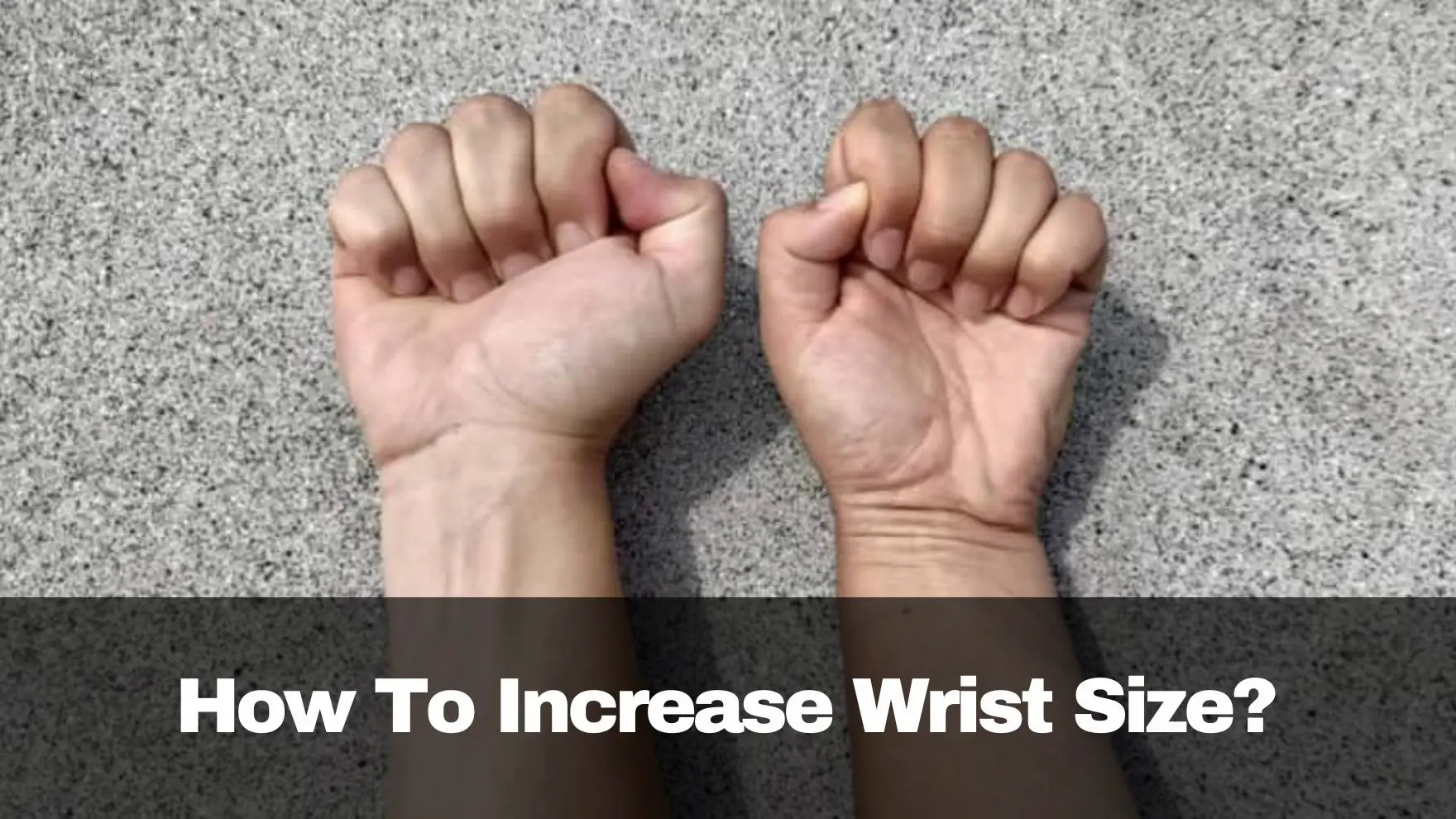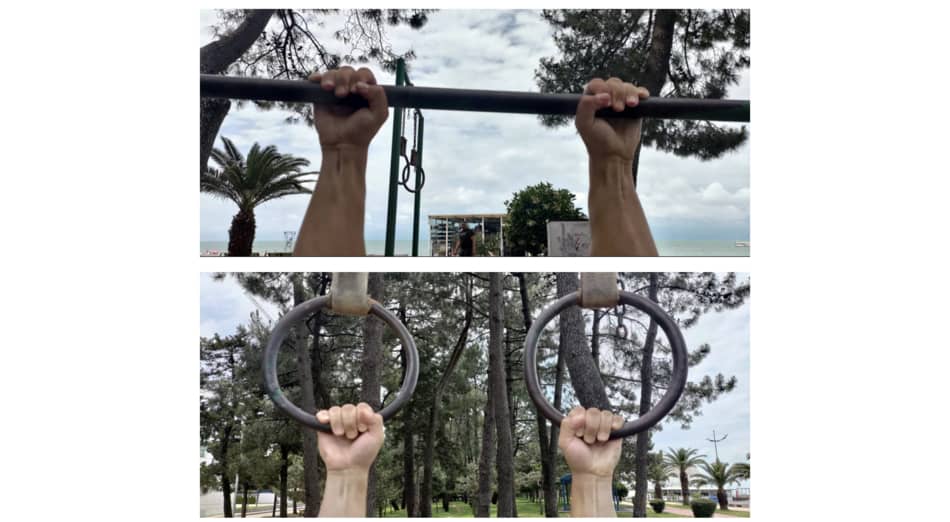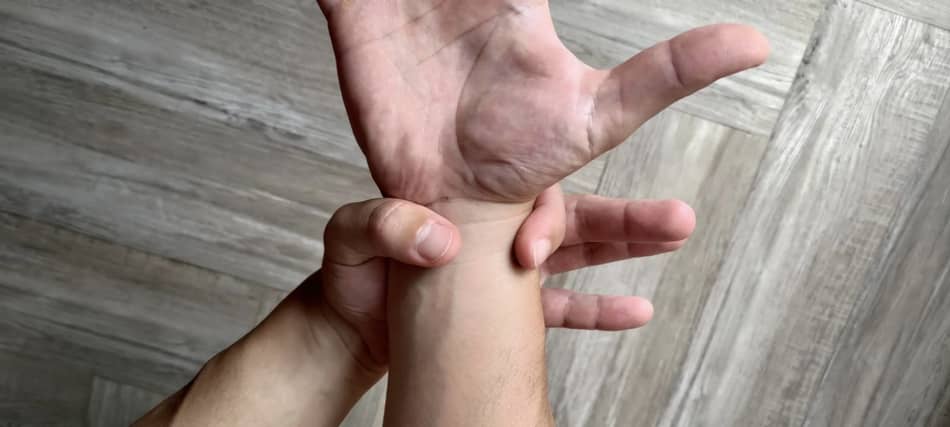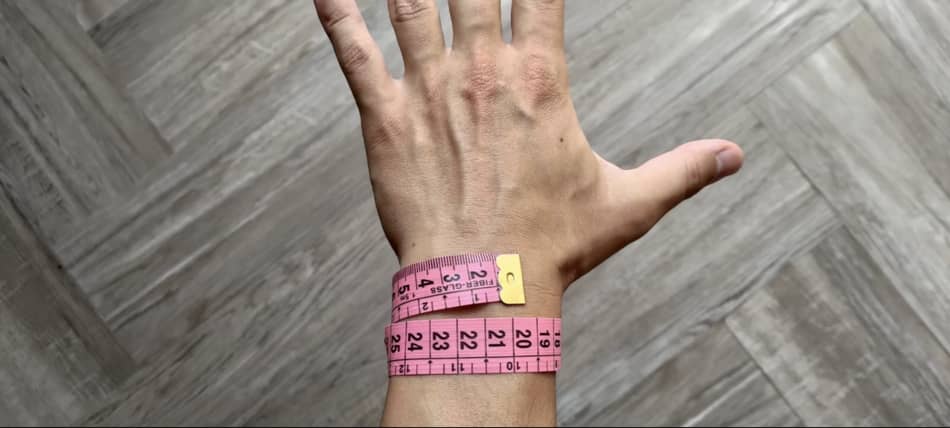
To increase wrist size, combine strength training, proper nutrition, and consistency. Focus on isolation exercises like wrist curls, reverse curls, and grip strengthening exercises, as well as compound exercises like deadlifts, chin-ups, and farmer’s walks. These compound movements not only help to strengthen your grip and forearms but also increase the cortical thickness of the wrists. Include foods rich in protein and calcium for bone and muscle growth. Wrist size increases gradually with consistent effort, and genetics play a significant role.
While some people are genetically blessed with bigger wrists and masculine forearms, others have to work hard for years to increase their wrist size. The good news is that increasing wrist size is possible. Today I will explain why some people have skinny wrists and, most importantly, how to increase wrist size through exercise and diet for both males and females. Here are 9 ways to increase wrist size at home.
- Use Heavy Resistance Training: Engage in exercises that challenge your wrist and forearm muscles with substantial weight.
- Perform Wrist Mobility Exercises: Enhance joint mobility and reduce injury risk with stretches and mobility drills.
- Use Regular or Trap Bar Deadlifts: Incorporate these lifts to build grip strength and indirectly engage wrist muscles.
- Use Ring Pull-Ups Instead of the Bar: Rings engage stabilizing muscles, increasing wrist and forearm activation.
- Perform Farmers Walk Exercise with Dumbbells: Carry heavy dumbbells to develop grip and forearm endurance.
- Do Kettlebell Swings for Reps: Kettlebell swings improve grip strength and condition wrist stabilizers.
- Try Doing Dips: Bodyweight dips engage forearms and wrists, contributing to strength and size.
- Use Drop Sets and Super Sets: Enhance hypertrophy by fatiguing muscles through high-intensity techniques.
- Prioritize Progressive Overload: Gradually increase resistance or intensity to stimulate muscle growth.
- Incorporate Nutrition Guidance: Consume protein-rich foods, healthy fats, and micronutrients like calcium.
- Emphasize Rest and Recovery: Allow time for muscle repair by prioritizing sleep and rest days.
- Stretch and Warm-Up: Reduce injury risk with a dynamic warm-up routine before workouts.
- Maintain Consistency: Commit to a regular workout schedule for gradual progress.
- Track Your Progress: Log your exercises, reps, and weights to monitor improvements and adjust accordingly.
1. Use Heavy Resistance Training To Increase Wrist Size
Heavy resistance training increases wrist size by promoting muscle growth, improving bone density, and strengthening tendons and ligaments. It increases tension on muscles during exercises, leading to micro-tears that repair stronger. So doing exercises like wrist curls, extensions, and compound lifts enhances wrist development through progressive overload and grip strength improvement.
Progressive overload makes your wrist bigger. This happens because lifting heavier things makes your muscles adapt and get stronger. This also helps the tissues around the muscles. Muscle growth (hypertrophy) is sped up by consistently challenging your muscles. Focus on flexors and extensors in your forearms. Heavy weights are great for these muscles, which control your wrist and grip. Exercises like curls, reverse curls, and big lifts like deadlifts will make them stronger.
The following list shows heavy resistance training exercises to make your wrists bigger.
- Deadlifts
- Chin-ups
- Pull-ups
- Farmers’ walks
- Push-ups
- Kettlebell swings
These exercises will trigger hypertrophy and strength gains in the grip, forearms, arms, and wrists. To further enhance wrist size, incorporate direct forearm training such as wrist rollers, towel pull-ups, fat grip biceps curls, or knuckle push-ups, especially if you lack access to a well-equipped gym. These exercises are perfect for home workouts, and since they don’t require heavy weights, you can perform them almost daily.
2. Perform Wrist Mobility Exercises To Increase Wrist Size
Wrist mobility exercises boost muscle growth in a few ways. First, they make your wrists more flexible. Second, they wake up muscles you don’t use a lot. This helps your muscles grow bigger and stronger. It also makes your wrists work together better. Mobility exercises boost blood flow. This delivers key nutrients for muscle repair, which helps your wrists grow stronger and bigger.
There are many wrist mobility exercises you can choose, but in my experience, movements like wrist flexor and extensor stretches, wrist circles, and prayer stretches are the best. Keep in mind that wrist mobility exercises are not the same as static stretches. Wrist mobility exercises should be the first thing you start when preparing to train your wrists. These exercises are usually gentle and do not require a lot of strength.
Wrist mobility is crucial, especially for climbers, gymnasts, and martial artists. This mobility program can be done at home to improve wrist flexibility and range of motion by training the following movements.
- Pronation: Rotating the forearm so the palm faces downward or backward.
- Supination: Rotating the forearm so the palm faces upward or forward.
- Ulnar Deviation: Movement of the wrist toward the pinky (ulnar) side.
- Radial Deviation: Movement of the wrist toward the thumb (radial) side.
- Circumduction: A circular motion combining flexion, extension, abduction, and adduction.
Wrist mobility exercises are better than static stretches. Why? They make your muscles work and become stronger. These exercises increase blood flow, which helps muscles grow. Passive stretching doesn’t do this. You can think of wrist mobility as a way to improve the range of motion and prevent injury, rather than to build stronger forearms.
3. Use Regular or Trap Bar Deadlifts To Increase Wrist Size
You can increase wrist size with exercises by doing conventional or trap bar deadlifts (as long as you use optimal load). Deadlifts make your wrists stronger by:
- Putting stress on your wrist bones: This stress tells your body to make those bones stronger and thicker.
- Pushing them to work hard: This helps your wrist muscles and bones grow.
- Making your wrist muscles squeeze tight: This makes those muscles bigger and better at keeping your wrist steady.
Here you can see a video tutorial from Christian Thibaudeau about how to do many varieties of deadlifts.
Deadlifts and similar exercises build bigger wrists. They work forearm muscles and grip strength. Lifting heavy weights regularly makes these muscles larger, which also increases wrist size. What’s more, lifting heavy weights stimulates bone growth and increases testosterone levels throughout the body. This means that an increase in bone density occurs in the entire body, not just your wrists.
One 2011 study from Loyola Marymount University in Los Angeles showed that doing deadlifts at 60 to 90% of 1RM (3 days per week) for 24 weeks was enough to increase bone mineral density by 2.7 to 7.7%.
Be aware that deadlifts are one of the most complex movements in strength training which requires good mobility and correct technique. If you never tried deadlifts with the barbell, I recommend either hiring a trainer or using a trap bar instead.
4. Use Ring Pull-Ups Instead of the Bar To Increase Wrist Size
One of the best ways to grow your wrists is by doing pulling exercises, such as chin-ups and pull-ups. Compound pulling movements like these require strength in the grip and forearms, which are essential for wrist growth. Therefore, if you want bigger wrists, you should be doing pulling exercises more than once per week. For your safety, I recommend using gymnastic rings because they allow you a greater range of motion, compared to a straight bar. Unlike doing pull-ups on the straight bar, rings allow you to externally rotate your shoulders on the way up. Plus, holding rings means less strain on your wrists.
Here’s a photo of me hanging on the pull-up bar and holding the Olympic rings in my local park.

5. Perform Farmers Walk Exercise with Dumbbells To Increase Wrist Size
You can build forearm strength and muscle (which can lead to thicker wrists) by doing strongman training exercises like farmers’ walks or loaded carries. The goal of this exercise is to pick up heavy dumbbells and carry them for a distance, usually measured in meters. While it may seem easy on the surface, make no mistake: this exercise is no joke. Every farmers’ walk leaves my forearms burning.
There are several ways to make this exercise more challenging. You can add 2.5-5kg more weight, go a farther distance, or do both. You can also reduce rest time between sets. For beginners, I recommend using a weight that you can hold for 20-30 seconds. Consider doing loaded carries in place of your usual cardio (after your strength training session) or integrate them into your metabolic conditioning routine.
Here is the tutorial from Buff Dudes Workouts on how to do farmers’ walk exercises correctly.
6. Do Kettlebell Swings for Reps To Increase Wrist Size
Want to increase wrist size at home without a gym? Try kettlebell swings! Like deadlifts, kettlebell swings utilize a hip hinge movement, but with a dynamic swinging motion. While they may appear simple, proper form is crucial. This involves maintaining a straight back, feet shoulder-width apart, and a neutral head position throughout the exercise.
Are you ready to get bigger wrists? I’ve already written a number of articles where I explain how to use kettlebell swings.
Here is the sample program for increasing your wrist size with 3 rounds of doing kettlebell swings in just 6 minutes.
| Exercise | Repetitions |
|---|---|
| Kettlebell Swings | 10 reps |
| Rest | 1 minute |
| Kettlebell Swings | 20 reps |
| Rest | 1 minute |
| Kettlebell Swings | 25 reps |
| Rest | 1 minute |
You can also combine kettlebell swings with pushups if you don’t have access to a gym. To be honest, if I had to choose just one exercise for wrist strength (without gym access), it would definitely be kettlebell swings.
7. Try Doing Dips To Increase Wrist Size
Push-ups are great bodyweight exercises that help to strengthen wrists. Some people like to do knuckle push-up variations to condition their wrists to pressure, while others find it helps build wrist stability. Knuckle push-ups are a go-to exercise for many gymnasts to strengthen their forearms. However, doing knuckle push-ups may be too difficult for beginners because they require having a narrower stance, directly under your wrists.
If you’re looking for a beginner-friendly alternative to knuckle push-ups, consider incline push-ups or wall push-ups to build wrist strength gradually.
Here’s a photo of me doing dips in front of my community gym.

You can see my wrist is getting a lot of pressure because of this flexed wrist position. Dips are a go-to exercise for building triceps, shoulders, pecs, and forearms. Many people find dips preferable to push-ups because they allow you to add more load without adding unnecessary stress to your wrists. Another advantage is that dips can be done either in the gym or outside in the park.
8. Use Drop Sets and Super Sets To Increase Wrist Size
Want thicker wrists? Focus on exercises that create constant tension in your forearms. Supersets, drop sets, and pyramids are great techniques to achieve this. This continuous tension, also known as mechanical tension, is key to stimulating bone remodeling and growth in your wrists.
While lifting heavy is important for building strength and stimulating bone density, don’t rely solely on heavyweights. Incorporate lighter weights and higher repetitions to increase time under tension. This means keeping your muscles working for longer periods, which promotes muscle growth and triggers the release of anabolic hormones that further support bone and muscle development.
Here’s an example of the drop set and how it works:
- Pick up any exercise that targets arms (e.g. biceps curl).
- Perform 8 to 12 reps (or until muscle failure).
- Once you reach muscle failure, quickly reduce the weight and continue with the exercise until you reach that point again.
- Repeat the process for 2-5 rounds.
How Long Does it Take to Increase Wrist Size?
Increasing wrist size takes 6-12 months of consistent strength training and proper nutrition. Progress depends on factors like age, genetics, and exercise intensity. Compound exercises like wrist curls and grip strengthening can improve muscle and tendon development, leading to gradual size increases.
In my experience, growing your wrists will take months, sometimes even years. Bone remodeling and bony hypertrophy are completely different than muscle hypertrophy. While muscles can grow relatively quickly, bone changes happen much more gradually. Wrists are made of bones, tendons, ligaments, and other soft tissue. Bone growth is slower than muscle growth.
Things that will determine how much time it takes to increase wrist size are gender, age, genes, type of physical activity, diet, and other environmental factors.
Can Wrist Size be Increased with Exercise?
Wrist size cannot be significantly increased through exercise, as it is primarily determined by bone structure and genetics. However, strength training exercises can enhance muscle and tendon development around the wrist, giving the appearance of slightly larger wrists.
After a certain age, exercise, and diet become crucial for growing or maintaining wrist size. If you’re looking to maximize your wrist circumference but haven’t been blessed with favorable genetics, heavy compound movements are key. These exercises can increase wrist size even if they don’t directly involve the wrists themselves.
Here’s how it works:
- Doing heavy squats will lead to an acute increase in your testosterone level (keep in mind that the spike is only temporary).
- A temporary increase in testosterone, IGF-1, and growth hormone triggers positive changes and facilitates muscle and bone growth.
- Those positive effects work on the whole body (not only on the muscles that have been worked during squats).
The bad news is that most of the exercises have to be done in the gym (unless you have a badass garage gym with a squat rack and plenty of bumper plates).
What to Eat to Increase Wrist Size?
To increase wrist size, eat protein-rich foods like chicken, fish, and eggs to support muscle growth. Include healthy fats from nuts and avocados, and carbohydrates like whole grains for energy. Consuming calcium-rich foods, such as dairy, strengthens bones, while hydration and vitamin D aid nutrient absorption. To maximize results, pair this nutrition plan with wrist-specific exercises.
In general, there is no food that will magically make your wrists bigger. Wrist size is determined by bone mass and bone mineral density. When it comes to nutrition, bone mineral density is regulated by calcium, vitamin K2, and vitamin D. Therefore, focus on ensuring your body receives adequate nutrients and vitamins that contribute to healthy bone remodeling.
Focus on a diet rich in protein and calcium. Supplementing with vitamin D can also be beneficial. This will help keep your bones strong and prevent future problems.
Does Wrist Size Increase with Age?
Wrist size does not typically increase with age in adults as bone growth stops after puberty. Changes in wrist size over time are more likely due to weight fluctuations, muscle development, or medical conditions like fluid retention rather than age itself.
Why is My Wrist So Small?
Having small wrists can result from genetics, body structure, or low muscle mass. One of the main reasons why people have skinny wrists is genes. The size of your wrists is mainly predicated on the DNA. According to a 2002 study in the Journal of Clinical Densitometry by Dr. Hong-Wen Deng from the Tulane School of Medicine, “the heritability of bone size at the spine, hip, and wrist is over 50%.” This means that if your patterns had small wrists, there are 50 percent chances that you will have small wrists, too.
Another factor influencing wrist size is bone density, which is partly determined by genetics. A 1998 study by Ferrari et al. in the Division of Bone Diseases at the University Hospital of Geneva showed that familial resemblance for bone mineral mass is evident even before puberty. They found that 18-37% of bone traits were directly linked to maternal lineage. Essentially, this means that a significant portion of your wrist size and bone structure is predetermined by your DNA, even before you’re born. This is because genes inherited from your parents influence various factors related to bone development, including collagen production and bone cell activity.
The difference in wrist size between people is also determined by body frame. Whether your wrist is considered small or large depends on your body shape (bone structure) and your height. Body frame size is typically assessed by comparing your wrist circumference to your height.
Wrist size is also considered relative to a person’s height and gender. Let me give you a couple of examples. A female that has a 7-inch wrist circumference and a height under 5’1″ is considered to have a large wrist size. In contrast, a male that has a 7-inch wrist circumference and a height above 5’11” is considered to have a small wrist size.
How To Know If You Have Small Wrists?
To determine if you have small wrists, measure the circumference of your wrist with a tape measure. Generally, for women, wrists smaller than 5.5 inches (14 cm) are considered small. For men, wrists under 6.5 inches (16.5 cm) are typically categorized as small. The size of the wrists is mainly determined by genetic makeup, bone mass, and physical activity (especially during childhood and adolescence).
The second way to know if you have a small, average, or big wrist size is by wrapping your thumb and index finger around your wrist.
Here’s a photo of how I measure my wrist size using this method.

I’m grabbing my left hand with my index finger and thumb. The distance between the tip of my thumb and the tip of my index finger determines if the wrists are skinny, average, or massive.
Here’s how it works:
- Small wrist size – You know if you have a small wrist size if the thumb and index finger can overlap with each other.
- Average wrist size – You know if you have an average wrist size if the thumb and index finger meet each other.
- Large wrist size – You know if you have a large wrist size if the thumb and index finger cannot touch or meet each other.
How To Measure Your Wrist Size?
To measure your wrist size, start by wrapping a flexible measuring tape or a piece of string around the wrist where you typically wear a watch. Mark the overlap, then measure the string against a ruler if used. This method ensures an accurate wrist circumference for jewelry or watch sizing.
One of the easiest ways to measure your wrist size is by using a measuring tape. Here to how to measure your wrists step by step..
- Wrap a measuring tape around your wrist.
- Place the tape around your wrist (in the same area you wear a watch) to determine the circumference of your wrist in inches.
- The tape should be fitted as close to the palm as possible.
- You can measure your wrist size by using centimeters or inches.
- Journal your results by writing down your numbers on your phone or notepad.
- You can measure your wrist size every 4 weeks.
Here’s a photo of my wrist using my wife’s pink measuring tape.

Currently, my wrist is around 9 inches. A couple of years back it was less than 8 inches.
One of my favorite quotes (I think it was from Paul Chek) says that ‘if you’re not measuring, you’re guessing’. What does it mean? This means that one of the most effective ways to know if you’re making progress or not is by measuring the results. Measuring your wrist size not only provides you with a baseline of where you are right now but also shows how fast you are making progress.
Do Small Wrists Mean Low Testosterone?
Small wrists do not directly indicate low testosterone levels. Wrist size is determined by bone structure and genetics, whereas testosterone influences muscle mass, fat distribution, and energy levels. Other symptoms or tests are required to assess testosterone levels.
For example, according to Dr. Lawrence Riggs from the Mayo Clinic College of Medicine, “the major cause of osteoporosis in women is estrogen deficiency due to menopause, while in men, age-related testosterone deficiency.”
Do Small Wrists Mean a Small Frame?
Small wrists often indicate a smaller bone structure or frame, but they do not always mean a small overall body size. Wrist size can be influenced by genetics, and measuring wrist circumference is one method to estimate body frame size in proportion to height.
You can determine if you have a small, large, or average wrist size by measuring your body frame size index. In general, people who have a small body frame also happen to have a small wrist. Having a small wrist is nothing to worry about. In fact, some studies have shown that a small wrist is a good indicator of a lower body fat percentage. On the other hand, a high waist circumference can be a strong predictor of hypertension.
According to Reza Mohebi MD from Harvard Medical University, “increase in wrist circumference is independently associated with both hypertension and cardiovascular disease.”
Does Wrist Size Really Matter?
Wrist size can matter depending on context. For watches, wrist size helps determine appropriate strap lengths or dial sizes. In health or fitness, wrist size is sometimes used to estimate body frame size. For fashion, it influences bracelet or accessory choices. Its relevance varies based on practical needs rather than inherent significance.
Personally, I don’t think too much about the wrist size, unless I’m about to get a new watch. However, when you look at the global trends, strong forearms and big wrists are in style.
They surveyed hundreds of women and concluded that arms were the 3rd most attractive male body part. Going further, I did a small survey where I interviewed several people and asked them how attractive they find guys and gals with small wrists. Here you can read my article about how attractive are small wrists.
Plus, wrist size can affect strength. People who have smaller wrists (and smaller frames) may be weaker than their fellow peers who have more bony structures.
Is it Possible to Increase Wrist Size?
Wrist size can increase through strength training and hypertrophy-focused exercises targeting the forearm and hand muscles. Bone structure changes minimally in adults, but muscle development can enhance overall wrist girth. Wolff’s law states that bones adapt to mechanical stress, growing stronger and thicker when subjected to consistent strain, which may slightly impact wrist size.
Bone remodeling leads to adaptive changes where bone becomes stronger to resist this loading in the future. The evidence of Wolff’s law is seen in sports like:
- Tennis players – The hand of the tennis player that is used to hold the racquet is usually stronger and bigger than others.
- Baseball players – A pitcher throwing a baseball have usually one arm stronger and bigger than the other.
- Rodeo athletes – One very recent study has shown that “bony hypertrophy in the ulna of the grip arm of bareback rodeo riders was 42.3% greater on average when compared to the non-grip arm.”
In other words, people who constantly use one hand over the other will likely develop stronger but asymmetrical arms. Also, guys who are doing judo, grappling, or any form of martial arts where you use your grip to fight with the opponent usually have larger wrists and forearms.
